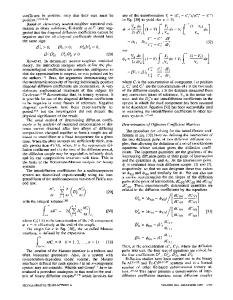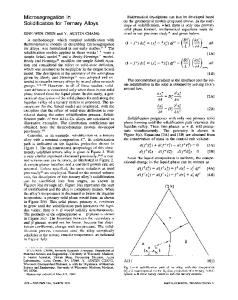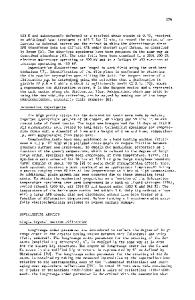Microstructure And Ternary Phases In Al-rich Al-Y-Ni Alloys.
- PDF / 2,336,275 Bytes
- 6 Pages / 612 x 792 pts (letter) Page_size
- 21 Downloads / 256 Views
MM5.10.1
Microstructure And Ternary Phases In Al-rich Al-Y-Ni Alloys. A.L.Vasiliev, M.Aindow, M.J.Blackburn, T.J.Watson1 Department of Metallurgy and Materials Engineering, Institute of Materials Science, University of Connecticut, Storrs, CT 06269-3136, USA. 1 Pratt & Whitney, Materials & Process Engineering, Structural Alloys & Processes, 400 Main Street, Mail Stop 114-40, East Hartford, CT 06108, USA. ABSTRACT The results of a transmission electron microscopy study on the crystal structures and morphologies exhibited by each of the phases in a set of four Al-rich Al-Y-Ni alloys which contain 1.7-4.5 at. % Y and 3.5-10.1 at. % Ni are presented. It is shown that each alloy contains fcc-Al, a binary Al3Ni or Al3Y phase (depending on alloy composition), and a ternary phase. The same ternary phase was found in each alloy and this was found to correspond to a new phase Al19Ni5Y3 (Cmcm, a=0.4025 nm, b=0.799 nm and c= 2.689 nm, Al19Ni5Gd3 structure type). In many cases, the ternary particles also contain embedded slabs of the equilibrium Al23Ni6Y4 phase. This phase mixture did not decompose even after extended annealing. INTRODUCTION Al-Y-Ni alloys processed through the amorphous state exhibit highly refined microstructures and significant improvements in strength over conventional Al alloys [1,2]. As such, they are now being considered for aerospace applications. One possible complication with Al-RE-TM (RE-rare earth and TM-transition metal) alloys is that the intermetallic compounds can lead to embrittlement. However, it has been shown that it is possible to define compositions in the Al-YNi system that combine intermediate strength (700 - 800MPa) with quite high ductility. To understand how these mechanical properties are achieved, and what scope there is for further improvement, we have been investigating the structural and morphological features of the intermetallic phases in this system. A variety of different intermetallic phases have been reported for Al-Y-Ni alloys and the stability of the various phases was clarified in a recent study by Raggio et al. [3]. The authors compared the results described by others [4-8] with data obtained from a series of ternary alloys subjected to long-term heat treatments. The only phase about which there is significant controversy is the Al16Ni3Y phase, first reported by Rykhal and Zarechnyuk [4]. Although other groups also claim to have observed this phase [9,10], only the symmetry and lattice parameters have been reported, not the atomic positions. Moreover, Raggio et al. [3] discounted this phase, at least as an equilibrium compound. In this paper we present the results of a transmission electron microscopy (TEM) study on the crystal structures and morphologies exhibited by the phases in a set of four devitrified Al-Y-Ni alloys which contain 1.7-4.5 at. % Y and 3.5-10.1 at. % Ni. EXPERIMENTAL DETAILS Powders of the four alloys were prepared from pre-prepared master melt by gas atomization
MM5.10.2
at Valimet Corporation. The 325 mesh fractions were hot pressing at 300 MPa
Data Loading...











